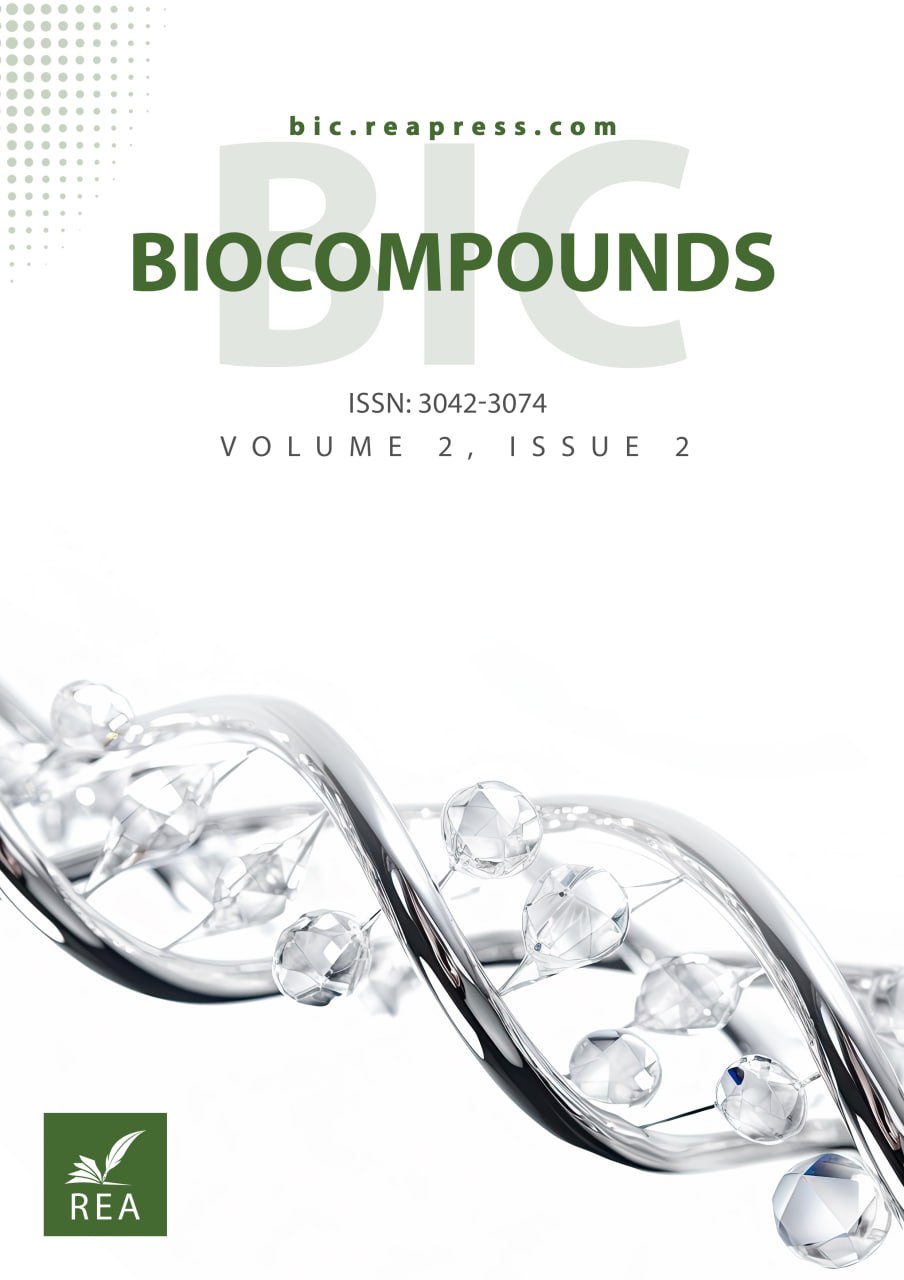Antioxidant and Anticancer Activities of the Flower Extract of Rhynchocorys Elephas on A549 Lung Cancer Cells
Abstract
Lung cancer is one of the most common types of cancer, and chemotherapy remains a main therapeutic approach; however, its severe side effects often limit its use. Therefore, the present study aimed to determine the antioxidant compounds of Rhynchocorys Elephas flower extract and to evaluate its inhibitory effects on the growth of A549 lung cancer cells. The flowers of R. Elephas were collected from Tonekabon, air-dried in the shade, and powdered. The extracts were prepared by maceration, and the total phenolic, flavonoid, and anthocyanin contents were quantified. The A549 cell line was cultured and exposed to various concentrations of the flower extract (62.5–2000 μg/mL) for 24, 48, and 72 hours. Cytotoxicity was then assessed using the MTT colorimetric assay. The results showed that the R. Elephas flower extract was rich in antioxidant compounds, particularly phenolics, with the highest concentration (13.98 ± 0.269 mg/g dry weight) observed in the extract. Moreover, MTT assay results revealed that cell viability decreased in a concentration- and time-dependent manner. The highest cytotoxic effect was observed at 2000 μg/mL after 72 hours of incubation, where cell viability decreased to 80.12%. Based on these findings, the flower extract of R. Elephas is a rich source of antioxidant compounds and, considering the adverse effects of chemotherapy drugs, can be recommended for further pharmacological investigations as a potential natural anticancer agent.
Keywords:
Antioxidant compounds, MTT assay, Lung cancer, Rhynchocorys Elephas, Total phenolicsReferences
- [1] Moure, A., Cruz, J. M., Franco, D., Domı́nguez, J. M., Sineiro, J., Domı́nguez, H., … ., & Parajó, J. C. (2001). Natural antioxidants from residual sources. Food chemistry, 72(2), 145–171. https://doi.org/10.1016/S0308-8146(00)00223-5
- [2] Ebrahimabadi, A. H., Ebrahimabadi, E. H., Djafari-Bidgoli, Z., Kashi, F. J., Mazoochi, A., & Batooli, H. (2010). Composition and antioxidant and antimicrobial activity of the essential oil and extracts of Stachys inflata Benth from Iran. Food chemistry, 119(2), 452–458. https://doi.org/10.1016/j.foodchem.2009.06.037
- [3] Silvestri, G. A., Alberg, A. J., & Ravenel, J. (2009). The changing epidemiology of lung cancer with a focus on screening. British medical journal, 339, 451-454. https://doi.org/10.1136/bmj.b3053
- [4] Shokralezadeh, M., Poresh, A., Shahani, S., Habibi, A., & Zar, Z. (2013). Investigating the effect of cytotoxicity of Lagenaria siceraria plant extract on lung cancer cell line. Journal of Mazandaran university of medical sciences, 22(97), 225-230. (In Persian). http://jmums.mazums.ac.ir/article-1-1822-fa.html
- [5] Majnooni, M. B., Ramin Abiri, Peyman Malek Khatabi, & Hadi Adibi. (2009). Study of antimicrobial effects of trigonella foenum hydro-alcoholic extract on different bacterial strains. Medical laboratory journal, 3(1), 31. (In Persian). https://www.magiran.com/paper/709832A
- [6] Azizianshermeh, O., Valizadeh, J., Noroozifar, M., Qasemi, A. (2016). Investigating the antimicrobial activities of silver nanoparticles biosynthesized by aqueous extract of sambucus ebulus L. Journal of Ilam university of medical sciences, 24(5), 92-108. (In Persian). https://www.sid.ir/paper/90022/en
- [7] Babakhani, B., Houshani, M., Motalebi Tala Tapeh, S., Nosratirad, R., Shoja Shafiee, M., & Heidari keshel, S. (2019). The evaluation of antioxidant and anticancer activity of alfalfa extract on MCF7 cell line. Regeneration, reconstruction & restoration (RRR), 4(1), 9–14. https://doi.org/10.22037/rrr.v4i1.29646
- [8] Gandhi, S., & Abramov, A. Y. (2012). Mechanism of oxidative stress in neurodegeneration. Oxidative medicine and cellular longevity, 2012(1), 428010. https://doi.org/10.1155/2012/428010
- [9] Emami, S. N., Lindberg, B. G., Hua, S., Hill, S. R., Mozuraitis, R., Lehmann, P., … ., & Faye, I. (2017). A key malaria metabolite modulates vector blood seeking, feeding, and susceptibility to infection. Science, 355(6329), 1076–1080. https://doi.org/10.1126/science.aah4563
- [10] Larbi, A., Fortin, C., Dupuis, G., Berrougui, H., Khalil, A., & Fulop, T. (2014). Immunomodulatory role of high-density lipoproteins: Impact on immunosenescence. A journal of geriatric medicine and gerontology, 36(5), 9712. https://doi.org/10.1007/s11357-014-9712-6
- [11] Pourmorad, F., Hosseinimehr, S. J., & Shahabimajd, N. (2009). Antioxidant activity, phenol and flavonoid contents of some selected Iranian medicinal plants. African journal of biotechnology, 5(11), 11 https://doi.org/10.4314/ajb.v5i11.42999
- [12] Meda, A., Lamien, C. E., Romito, M., Millogo, J., & Nacoulma, O. G. (2005). Determination of the total phenolic, flavonoid and proline contents in Burkina Fasan honey, as well as their radical scavenging activity. Food chemistry, 91(3), 571–577. https://doi.org/10.1016/j.foodchem.2004.10.006
- [13] Chang, C. C., Yang, M. H., Wen, H. M., & Chern, J. C. (2002). Estimation of total flavonoid content in propolis by two complementary colometric methods. Journal of food and drug analysis, 10(3), 178-182. https://www.jfda-online.com/journal/vol10/iss3/3/
- [14] Mita, S., Murano, N., Akaike, M., & Nakamura, K. (1997). Mutants of Arabidopsis thaliana with pleiotropic effects on the expression of the gene for β-amylase and on the accumulation of anthocyanin that are inducible by sugars. The plant journal, 11(4), 841–851. https://doi.org/10.1046/j.1365-313X.1997.11040841.x
- [15] Asmaa, M. J. S., Al-Jamal, H. A. N., Ang, C. Y., Asan, J. M., Seeni, A., & Johan, M. F. (2014). Apoptosis induction in MV4-11 and K562 human leukemic cells by Pereskia sacharosa (Cactaceae) leaf crude extract. Asian pacific journal of cancer prevention, 15(1), 475–481. http://dx.doi.org/10.7314/APJCP.2014.15.1.475
- [16] Jin, X., Jin, X., & Kim, H. (2017). Cancer stem cells and differentiation therapy. Tumor biology, 39(10), 1010428317729933. https://doi.org/10.1177/1010428317729933
- [17] Davoodi, S. H., Jamshidi-Naeini, Y., Esmaeili, S., Sohrabvandi, S., & Mortazavian, A. M. (2016). The dual nature of Iron in relation to cancer: A review. Iranian journal of cancer prevention, 9(6), 5607–5911. http://dx.doi.org/10.7314/APJCP.2015.16.14.5607
- [18] Lu, Y., Jiang, F., Jiang, H., Wu, K., Zheng, X., Cai, Y., … ., & To, S. S. T. (2010). Gallic acid suppresses cell viability, proliferation, invasion and angiogenesis in human glioma cells. European journal of pharmacology, 641(2), 102–107. https://doi.org/10.1016/j.ejphar.2010.05.043


